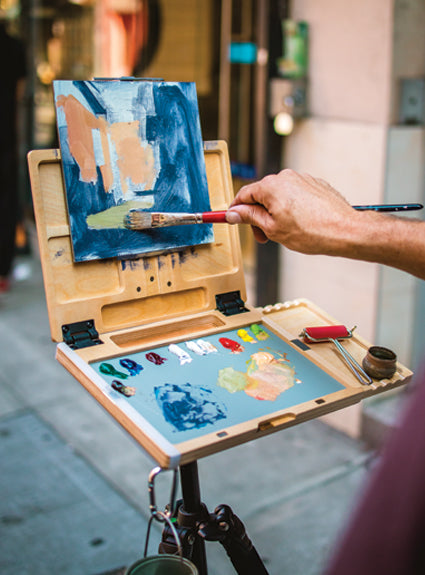INTERVIEW with CHRIS SAPER
LOCATION: Phoenix, AZ
CAREER: Full time artist, specializing in commission portraiture for the past 22 years
EDUCATION: Bachelor’s degree in Fine Art, & Business Administration minor; Master’s Degree: Heath Care Administration (MBA with a focus on health services/hospital administration/strategic planning)
LITTLE KNOWN FACT: Making a painting is a LOT like corporate strategic planning, in that the problem solving mind set is very similar – integrated and interrelated decision making.
WHEN WAS THE MOMENT YOU KNEW YOU WANTED TO BE A PAINTER?
I’ve never NOT thought of myself as an artist. Even when I was building a career as a health care executive, I took life drawing open studios over my lunch hours at the nearby Phoenix Art Museum, and instead of taking a trip to a tropical location during my vacations, I took art workshops.
WHAT IS YOUR STYLE OF PAINTING?
I think that my style is 'painterly', yet realistic and representative, with a bit of impressionism thrown in. I LOVE color and my still lifes have been described as having lively, riotous color.
.
DID YOU HAVE A MENTOR OR SOMEONE YOU LOOKED UP TO?
I am SO fortunate to have had four; Carl Sanger, my drawing teacher as a freshman at the Univ. of Wisconsin (Madison, WI); Ann Manry Kenyon, my first adult-education portrait teacher; William Whitaker, my continuing inspiration and teacher; and John Howard Sanden, who is a generous, terrific painter, and a consummate gentleman.
WHAT DO YOU LIKE MOST ABOUT WHAT YOU DO?
I love facing a new empty canvas every time, with all the promise and pitfalls. I love being free enough to fail. I love my wonderful clients. I love the intellectual demands of my job, much more rigorous than quantitative analysis ever was.
WHAT IS THE LARGEST HURDLE IN THE ARTS YOU HAVE HAD TO OVERCOME?
I don’t really think about hurdles except that they are something to jump over, go around, or smash.
WHAT IS ONE OF YOUR GOALS YET TO BE ACHIEVED?
Sure! I would love to become a really excellent painter. I want to explore so many techniques, approaches and to learn things I haven’t even thought of.
WHAT IS THE MOST IMPORTANT LESSON YOU HAVE LEARNED FROM PAINTING?
I have to say that my best lessons include never giving up, and keeping an open mind. l have learned to embrace failure. I recall an old Nike ad with a video of Michael Jordan alone in a gym – the text on the screen said something like: 'Michael Jordan has missed 14,230 (whatever) free throws. That is why he is a champion.'
.
WHAT ADVICE WOULD YOU PROVIDE TO ANYONE ASPIRING TO PAINT PROFESSIONALLY?
Leave your ego out of it. Don’t study with anyone who doesn’t paint better that you. Be OK about failing. Be sure you embrace 'perfect practice.' Most importantly, PAINT FROM LIFE – otherwise you won’t be able to paint successfully from photographs.
DO YOU HAVE A FAVORITE PAINTER?
I have so many…here are some deceased painters I love: JW Waterhouse, Jean Leon Gerome, Sir Alma Tadema, Renault, Vermeer. But I have to say that I literally am inspired each day by living painters, amazing talent, concept and approaches. I find that I am increasingly drawn to abstract experimental painters. BUT here is the thing... we should all have heroes, and I am grateful for all of mine.
WE HAVE TO ASK... WHAT IS YOUR FAVORITE NEW WAVE PALETTE?I have the
Academian Confidant. It fits my frame perfectly, and is lightweight, properly balanced and comfortable to hold. The value of the wood [stain] lets me judge the value of my paint properly, and I have enough mixing room. I can’t think of anything else a palette needs to do.
.
-Chris Saper










